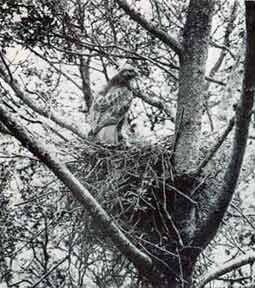Some Birds Of Britain, Page 2
By LEWIS WAYNE WALKER
Next day I was again in position by 11 a.m., the camouflage rearranged before my friendly farmer departed from the scene. Should 11 a.m. seem rather late in the morning to commence observation, I may explain that I had to motor several miles, and at the end of the journey climb to an altitude of two thousand feet from the river level in the valley below. It was not an uncommon experience to have to empty the radiator of boiling water and to refill it from a mountain brook which crossed the loose-surfaced road at the half way line. On a stormy day, it was next to impossible to make the journey at all.
The female hawk returned to the nest at 1:15, carrying in her talons a young rabbit, which she began to pluck immediately, pieces of the fur floating away in the wind and adhering to the lichen-covered bark. She tore the exposed flesh to feed the two young very carefully and tenderly for thirty-five minutes, giving the young all the tit-bits and eating the skin and coarser portions herself. During this visit, three exposures were made without disturbing her in any way, the shutter being allowed to close gently after exposures of one-half to one second. She returned again at 4: 50, feeding the young for half an hour.

A BUZZARD PLUCKING A RABBIT FOR HER YOUNG
The young did not fight nearly so much in her absence as they had the day before. As the young are hatched at intervals of two or three days, the older chick was considerably stronger than the other, and it is a fairly common experience to find that only the first youngster survives, the weaker one being pecked to death by the stronger during the first ten days. The nest of the gray heron was built in the top of a pine growing on the Mendips, which commanded a magnificent view over West Somerset to the Bristol Channel. The blind, a duplicate of that built for the rooks, was placed piece by piece in the top of an ash that overlooked the pine, nest and blind being twenty-one feet apart. Three other nests could be photographed from the blind, and as at least one of the eight adult birds was always at the nest, sessions in this tree top. were never dull. The easternmost nest contained two well-grown young, and the adult birds, a beautiful pair, would remain at the nest after feeding for an hour or more, resting or preening their plumage. The feeding is an exciting business resembling a "rugger" scrummage. A mass of partly digested eels and other small fish is disgorged into the bottom of the nest by the adult a few minutes after its arrival from the fishing grounds.
Apart from the quick movements of the young as they struggle and flap their growing wings, there is, even on a fine day, considerable movement of the upper branches of the trees so that for perhaps an hour or so on end serious photography is out of the question, and the observer merely watches as he waits for the breeze to moderate. This remark is not meant to indicate that there is no interest in watching, because often I have been so fascinated by some bird action new to me that I have forgotten to press the antinous release in my fingers to expose a plate already in position.
 Printer-friendly version
Printer-friendly version
